New recycling method makes solar cells even more environmentally friendly

Enlarge / All these pieces more or less pop apart after a brief chemical treatment. (credit: Israel Sebastian.)
For years, the arguments against renewable power focused on its high costs. But as the price of wind and solar plunged, the arguments shifted. Suddenly, concerns about the waste left behind when solar panels hit end-of-life became so common that researchers at the US's National Renewable Energy Lab felt compelled to publish a commentary in Nature Physics debunking them.
Part of the misinformation is pure nonsense. The primary ingredients of most panels are silicon, aluminum, and silver, none of which is a major environmental threat. Solar panels also have a useful lifespan of decades, and the vast majority of those in existence are less than 10 years old, so waste hasn't even become much of a problem yet. And, even once these panels age out, recycling techniques are available.
Perhaps the only realistic concern is that existing recycling technologies rely on nitric acid and can produce some toxic waste. But a group of researchers from Wuhan University have figured out an alternative means of recycling that avoids the production of toxic waste and is more energy-efficient as a bonus.